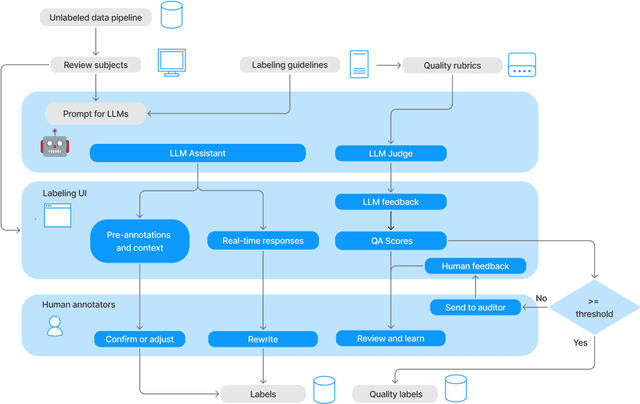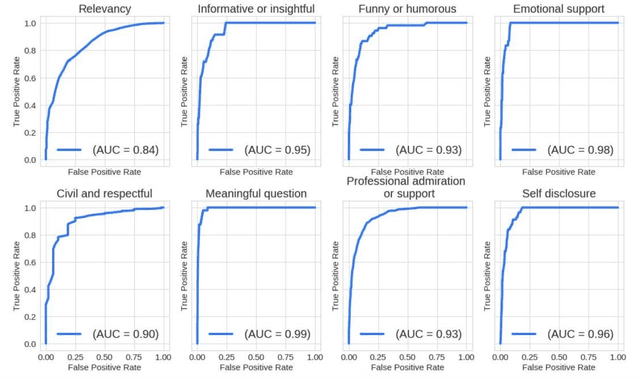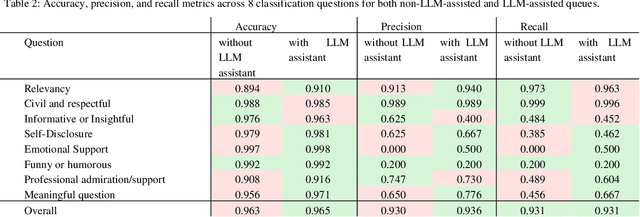Daniel Lee
Semantic Commit: Helping Users Update Intent Specifications for AI Memory at Scale
Apr 12, 2025Abstract:How do we update AI memory of user intent as intent changes? We consider how an AI interface may assist the integration of new information into a repository of natural language data. Inspired by software engineering concepts like impact analysis, we develop methods and a UI for managing semantic changes with non-local effects, which we call "semantic conflict resolution." The user commits new intent to a project -- makes a "semantic commit" -- and the AI helps the user detect and resolve semantic conflicts within a store of existing information representing their intent (an "intent specification"). We develop an interface, SemanticCommit, to better understand how users resolve conflicts when updating intent specifications such as Cursor Rules and game design documents. A knowledge graph-based RAG pipeline drives conflict detection, while LLMs assist in suggesting resolutions. We evaluate our technique on an initial benchmark. Then, we report a 12 user within-subjects study of SemanticCommit for two task domains -- game design documents, and AI agent memory in the style of ChatGPT memories -- where users integrated new information into an existing list. Half of our participants adopted a workflow of impact analysis, where they would first flag conflicts without AI revisions then resolve conflicts locally, despite having access to a global revision feature. We argue that AI agent interfaces, such as software IDEs like Cursor and Windsurf, should provide affordances for impact analysis and help users validate AI retrieval independently from generation. Our work speaks to how AI agent designers should think about updating memory as a process that involves human feedback and decision-making.
Kanana: Compute-efficient Bilingual Language Models
Feb 26, 2025Abstract:We introduce Kanana, a series of bilingual language models that demonstrate exceeding performance in Korean and competitive performance in English. The computational cost of Kanana is significantly lower than that of state-of-the-art models of similar size. The report details the techniques employed during pre-training to achieve compute-efficient yet competitive models, including high quality data filtering, staged pre-training, depth up-scaling, and pruning and distillation. Furthermore, the report outlines the methodologies utilized during the post-training of the Kanana models, encompassing supervised fine-tuning and preference optimization, aimed at enhancing their capability for seamless interaction with users. Lastly, the report elaborates on plausible approaches used for language model adaptation to specific scenarios, such as embedding, retrieval augmented generation, and function calling. The Kanana model series spans from 2.1B to 32.5B parameters with 2.1B models (base, instruct, embedding) publicly released to promote research on Korean language models.
Text-to-SQL Domain Adaptation via Human-LLM Collaborative Data Annotation
Feb 21, 2025Abstract:Text-to-SQL models, which parse natural language (NL) questions to executable SQL queries, are increasingly adopted in real-world applications. However, deploying such models in the real world often requires adapting them to the highly specialized database schemas used in specific applications. We find that existing text-to-SQL models experience significant performance drops when applied to new schemas, primarily due to the lack of domain-specific data for fine-tuning. This data scarcity also limits the ability to effectively evaluate model performance in new domains. Continuously obtaining high-quality text-to-SQL data for evolving schemas is prohibitively expensive in real-world scenarios. To bridge this gap, we propose SQLsynth, a human-in-the-loop text-to-SQL data annotation system. SQLsynth streamlines the creation of high-quality text-to-SQL datasets through human-LLM collaboration in a structured workflow. A within-subjects user study comparing SQLsynth with manual annotation and ChatGPT shows that SQLsynth significantly accelerates text-to-SQL data annotation, reduces cognitive load, and produces datasets that are more accurate, natural, and diverse. Our code is available at https://github.com/adobe/nl_sql_analyzer.
Comprehensive Evaluation for a Large Scale Knowledge Graph Question Answering Service
Jan 28, 2025



Abstract:Question answering systems for knowledge graph (KGQA), answer factoid questions based on the data in the knowledge graph. KGQA systems are complex because the system has to understand the relations and entities in the knowledge-seeking natural language queries and map them to structured queries against the KG to answer them. In this paper, we introduce Chronos, a comprehensive evaluation framework for KGQA at industry scale. It is designed to evaluate such a multi-component system comprehensively, focusing on (1) end-to-end and component-level metrics, (2) scalable to diverse datasets and (3) a scalable approach to measure the performance of the system prior to release. In this paper, we discuss the unique challenges associated with evaluating KGQA systems at industry scale, review the design of Chronos, and how it addresses these challenges. We will demonstrate how it provides a base for data-driven decisions and discuss the challenges of using it to measure and improve a real-world KGQA system.
KG-TRICK: Unifying Textual and Relational Information Completion of Knowledge for Multilingual Knowledge Graphs
Jan 07, 2025



Abstract:Multilingual knowledge graphs (KGs) provide high-quality relational and textual information for various NLP applications, but they are often incomplete, especially in non-English languages. Previous research has shown that combining information from KGs in different languages aids either Knowledge Graph Completion (KGC), the task of predicting missing relations between entities, or Knowledge Graph Enhancement (KGE), the task of predicting missing textual information for entities. Although previous efforts have considered KGC and KGE as independent tasks, we hypothesize that they are interdependent and mutually beneficial. To this end, we introduce KG-TRICK, a novel sequence-to-sequence framework that unifies the tasks of textual and relational information completion for multilingual KGs. KG-TRICK demonstrates that: i) it is possible to unify the tasks of KGC and KGE into a single framework, and ii) combining textual information from multiple languages is beneficial to improve the completeness of a KG. As part of our contributions, we also introduce WikiKGE10++, the largest manually-curated benchmark for textual information completion of KGs, which features over 25,000 entities across 10 diverse languages.
Enhancing Discoverability in Enterprise Conversational Systems with Proactive Question Suggestions
Dec 14, 2024Abstract:Enterprise conversational AI systems are becoming increasingly popular to assist users in completing daily tasks such as those in marketing and customer management. However, new users often struggle to ask effective questions, especially in emerging systems with unfamiliar or evolving capabilities. This paper proposes a framework to enhance question suggestions in conversational enterprise AI systems by generating proactive, context-aware questions that try to address immediate user needs while improving feature discoverability. Our approach combines periodic user intent analysis at the population level with chat session-based question generation. We evaluate the framework using real-world data from the AI Assistant for Adobe Experience Platform (AEP), demonstrating the improved usefulness and system discoverability of the AI Assistant.
Heavy-tailed Contamination is Easier than Adversarial Contamination
Nov 22, 2024
Abstract:A large body of work in the statistics and computer science communities dating back to Huber (Huber, 1960) has led to statistically and computationally efficient outlier-robust estimators. Two particular outlier models have received significant attention: the adversarial and heavy-tailed models. While the former models outliers as the result of a malicious adversary manipulating the data, the latter relaxes distributional assumptions on the data allowing outliers to naturally occur as part of the data generating process. In the first setting, the goal is to develop estimators robust to the largest fraction of outliers while in the second, one seeks estimators to combat the loss of statistical efficiency, where the dependence on the failure probability is paramount. Despite these distinct motivations, the algorithmic approaches to both these settings have converged, prompting questions on the relationship between the models. In this paper, we investigate and provide a principled explanation for this phenomenon. First, we prove that any adversarially robust estimator is also resilient to heavy-tailed outliers for any statistical estimation problem with i.i.d data. As a corollary, optimal adversarially robust estimators for mean estimation, linear regression, and covariance estimation are also optimal heavy-tailed estimators. Conversely, for arguably the simplest high-dimensional estimation task of mean estimation, we construct heavy-tailed estimators whose application to the adversarial setting requires any black-box reduction to remove almost all the outliers in the data. Taken together, our results imply that heavy-tailed estimation is likely easier than adversarially robust estimation opening the door to novel algorithmic approaches for the heavy-tailed setting. Additionally, confidence intervals obtained for adversarially robust estimation also hold with high-probability.
FunctionChat-Bench: Comprehensive Evaluation of Language Models' Generative Capabilities in Korean Tool-use Dialogs
Nov 21, 2024Abstract:This study investigates language models' generative capabilities in tool-use dialogs. We categorize the models' outputs in tool-use dialogs into four distinct types: Tool Call, Answer Completion, Slot Question, and Relevance Detection, which serve as aspects for evaluation. We introduce FunctionChat-Bench, comprising 700 evaluation items and automated assessment programs. Using this benchmark, we evaluate several language models that support function calling. Our findings indicate that while language models may exhibit high accuracy in single-turn Tool Call scenarios, this does not necessarily translate to superior generative performance in multi-turn environments. We argue that the capabilities required for function calling extend beyond generating tool call messages; they must also effectively generate conversational messages that engage the user.
Towards Cross-Cultural Machine Translation with Retrieval-Augmented Generation from Multilingual Knowledge Graphs
Oct 17, 2024



Abstract:Translating text that contains entity names is a challenging task, as cultural-related references can vary significantly across languages. These variations may also be caused by transcreation, an adaptation process that entails more than transliteration and word-for-word translation. In this paper, we address the problem of cross-cultural translation on two fronts: (i) we introduce XC-Translate, the first large-scale, manually-created benchmark for machine translation that focuses on text that contains potentially culturally-nuanced entity names, and (ii) we propose KG-MT, a novel end-to-end method to integrate information from a multilingual knowledge graph into a neural machine translation model by leveraging a dense retrieval mechanism. Our experiments and analyses show that current machine translation systems and large language models still struggle to translate texts containing entity names, whereas KG-MT outperforms state-of-the-art approaches by a large margin, obtaining a 129% and 62% relative improvement compared to NLLB-200 and GPT-4, respectively.
Model-in-the-Loop (MILO): Accelerating Multimodal AI Data Annotation with LLMs
Sep 16, 2024



Abstract:The growing demand for AI training data has transformed data annotation into a global industry, but traditional approaches relying on human annotators are often time-consuming, labor-intensive, and prone to inconsistent quality. We propose the Model-in-the-Loop (MILO) framework, which integrates AI/ML models into the annotation process. Our research introduces a collaborative paradigm that leverages the strengths of both professional human annotators and large language models (LLMs). By employing LLMs as pre-annotation and real-time assistants, and judges on annotator responses, MILO enables effective interaction patterns between human annotators and LLMs. Three empirical studies on multimodal data annotation demonstrate MILO's efficacy in reducing handling time, improving data quality, and enhancing annotator experiences. We also introduce quality rubrics for flexible evaluation and fine-grained feedback on open-ended annotations. The MILO framework has implications for accelerating AI/ML development, reducing reliance on human annotation alone, and promoting better alignment between human and machine values.
 Add to Chrome
Add to Chrome Add to Firefox
Add to Firefox Add to Edge
Add to Edge